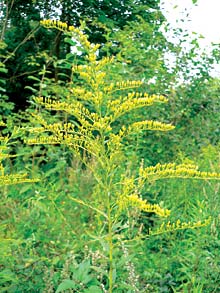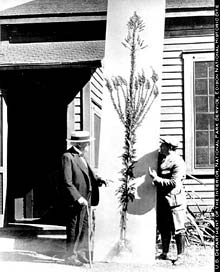A few weeks before Christmas in 1929, Thomas Edison left his home and laboratory in West Orange, N.J., for his winter retreat in Florida. With him were his wife, Mina, four servants and a dozen assistants. They traveled in a five-vehicle convoy, aiming for the inventor’s winter residence at Fort Meyers.

Along with a carefully packed cargo of glassware, meters, logbooks and other scientific necessities, Edison’s baggage also contained several tons of goldenrod stems. Fifty years had passed since Edison’s most recognizable invention, the filament light bulb, went to market. Others had followed: the kinetoscope (a rudimentary movie camera), the fluoroscope, the phonograph. In all, Edison held 1,093 patents for items he helped invent.
But the Edison of 1929 was the inventor in winter, in both the literal and figurative sense. His health was failing, and he would die just two years later at 82. He still had a few projects left in him, however, including a plan to transform a humble American field weed into a national resource.
Edison saw promise in goldenrod (genus Solidago) as a domestic source of latex for rubber manufacture, and he was dogged in his pursuit of it. (At the time, Britain held most of the world’s rubber-tree plantations and was setting the commodity’s price.) In 1927, he filed a patent application for a manufacturing process. At test plots in New Jersey, he bred the plant for size, yielding goldenrod twice the height of the field type.
But if Edison’s impulse was at least fundamentally sound, his timing couldn’t have been worse. The rise of synthetic, petroleum-derived rubber was just a few years away. DuPont received a patent for neoprene in 1931, and six years later, Standard Oil concocted butyl rubber out of petroleum byproducts. Other innovations followed, and the Second World War struck a final blow, weaning the world powers from their reliance on natural rubber.
Hindsight may be 20/20, but it’s easy to think that if Edison had instead set out to create the perfect ornamental goldenrod, his efforts might have been better rewarded.

Goldenrod is native to North America. It’s a big genus within the Asteraceae family, accounting for roughly 80 different species. Name a habitat, from high meadows to wetland margins to old fields, and there’s probably a goldenrod to be found there. Like many weeds, it follows the plow and has long been an inhabitant of fallow fields and fencerows. Its showy plumes of yellow blossoms make it conspicuous—and centuries ago earned it the false reputation of causing allergies. (Goldenrod pollen is heavy and is distributed by bees and wasps; ragweed pollen, the real culprit, is light and wind-borne.)
Nearly 40 species of goldenrod grow wild in North Carolina. Some have restricted ranges, such as Roan Mountain goldenrod (Solidago roanensis), which grows only in the mountains. Others, like Solidago canadensis, are ubiquitous, growing in nearly all of the state’s 100 counties.
The name Solidago derives from the Latin “solidus,” which can be taken to mean “whole” or “to make whole,” and the Greek suffix “ago,” which means “leader.” Roughly translated, the name means “uniter,” as in a plant that brings harmony to the body parts. This reflects the fact that goldenrod was once in demand as a natural medicine.
Only recently has there been much interest in improving goldenrod as an ornamental. That’s understandable for several reasons—including the persistent myth that it causes allergies, and the fact that it’s a weed, a scruffy plant that grows unbidden, without any help from us. In recent weeks I’ve seen it sprouting from people’s hedges and growing up and around their garbage cans. It doesn’t ask for much in the way of habitat.
The new cultivars are more mannerly than their wild relatives, and the best characteristics of the genus shine through them. ‘Fireworks’, an improvement on Solidago rugosa, reaches 3 feet and has long, arching blossoms. It was developed at the North Carolina Botanical Garden. ‘Crown of Rays’ is tall and deep gold; ‘Nags Head’ (S. hybridus) is a tall variety with prominent, straplike leaves and loose clusters of aster-sized blossoms. ‘Goldrush’ is a compact, bright-yellow improvement on the Northeast’s Alpine goldenrod (S. cutleri). ‘Laurin’ is a dwarf form with fuzzy blossoms. ‘Golden Fleece’, an improvement of S. sphacelata, has roughly heart-shaped leaves and grows to 18 inches. Other types of goldenrod have yet to come in from the wild but should, including sweet goldenrod (S. odora), a delicate species whose crushed foliage smells of anise.
Most goldenrod plants arise from a rosette of basal foliage and grow through the warm months, flowering in August and September. Like asters in this regard, goldenrod endures the heat of summer as a mute, vegetative thing, putting on its best show in autumn. And luckily for us, goldenrod’s hue is the perfect complement to the blues and purples of fall asters like New England aster (Symphyotrichum novi-belgii) and fragrant aster (Aster oblongifolius).
A final virtue is goldenrod’s drought tolerance. By all measures, this past summer’s drought made a wreck of local gardens and lawns. One survivor was goldenrod. I didn’t mow my yard in West Asheville, and as the season progressed I watched all sorts of menacing weeds sprout up: Johnson grass. Buffalo burr. Nightshade. It looked as if it had been seeded by the Addams Family lawn service.
There was another weed, a rangy specimen near the kitchen window, which I also let go. It grew bigger and bigger until about four weeks ago when, at 6 feet high and holding, it erupted into glorious bloom. I’m no botanist, but from what I can tell, it’s late goldenrod (Solidago altissima). I haven’t tried to make rubber from it yet, but who knows? With all the talk of “peak oil,” Edison’s last big idea might be ripe for a dusting off.


Before you comment
The comments section is here to provide a platform for civil dialogue on the issues we face together as a local community. Xpress is committed to offering this platform for all voices, but when the tone of the discussion gets nasty or strays off topic, we believe many people choose not to participate. Xpress editors are determined to moderate comments to ensure a constructive interchange is maintained. All comments judged not to be in keeping with the spirit of civil discourse will be removed and repeat violators will be banned. See here for our terms of service. Thank you for being part of this effort to promote respectful discussion.